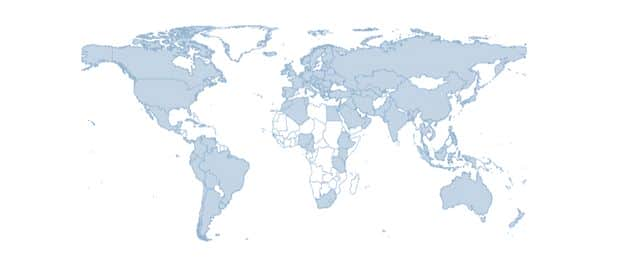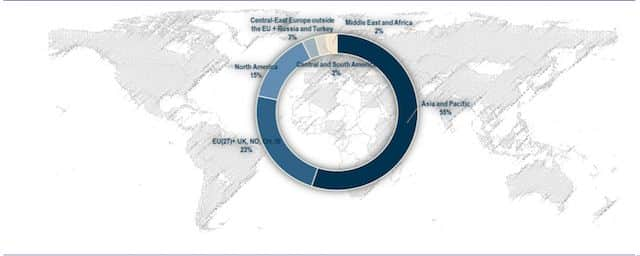
According to CSIL’s preliminary estimates, world production of furniture in 2021 will exceed US$ 500 billion;a stronger-than-expected recovery, mainly due to the major contribution from Europe and Asia. This estimate is based on processing of data from official sources, both national and international, that covers the 100 most important countries. Demand was globally strong with differencesacross countries and segments. However, production growth is subject to a series of constraints: raw material scarcity and growing prices, supply chain challenges, high costs of transport and container shortages. Moreover, systemic uncertainties, deriving from continuing trade restrictions and changing supply chain strategies, affect the entire furniture sector.
Figure 1 Percentage breakdown of world furniture production by region
More than half of world furniture production took place in Asia and the Pacific. The main furniture producer is China, followed at a distance by the United States,Germany and Italy.
In the last ten years international trade of furniture has grown faster than furniture production, and has consistently amounted to about 1% of international trade of manufactures, reaching about US$ 152 billion in 2018 and 2019. The pandemic has caused stagnation in 2020 but 2021 is a year of steep growth. Prospects for 2022 and 2023 are favourable, with uncertainties deriving from supply constraints and transport problems. The bulk of international trade of furniture originates in China, Vietnam, Poland, Germany and Italy, and goes to the United States, Germany, France, the United Kingdom, and the Netherlands (a trading hub).
On the consumption side, the lockdown experience highlighted the importance of home, which acquired a new centrality both for living and working. Spending more time at home pointed out the usefulness of having functional spaces for the whole family, possibly modular furniture also suitable for working from home. Consumers invested in improving their living spaces, often allocating to furniture substantial portions of income made available because of decreased expenditure for other leisure activities. For this reason, the worldwide pandemic-induced contraction in furniture consumption in 2020 was limited in size, affecting the different products of the furniture aggregate in different ways. Office furniture was more severely hit, following the decline in investments by both the industry and the service sector. Strong growth has resumed in 2021, with furniture consumption reaching a level well above the pre-pandemic values.
According to IMF World Economic Outlook (October 2021), World GDP growth is resuming in 2021 (5.9%), in 2022 (4.9%) and 2023 (3.6%). Growth prospects remain stronger for emerging and developing economies than for advanced economies. Uncertainties remain high, differences in the speed of recovery (both across and within countries) will be substantial and downside risks remain significant.
The CSIL ‘World Furniture Outlook’report, issued in December 2021, assumes that the international scenario will be as follows:
Table 1. Evolution of World GDP. Annual percentage change in real terms
| 2021 | 2022 | 2023 | |
| World | 5.9 | 4.9 | 3.6 |
| Advanced Economies | 5.2 | 4.5 | 2.2 |
| Emerging and Developing Economies | 6.4 | 5.1 | 4.6 |
Source: IMF, World Economic Outlook, October 2021
For the world as a whole (100 countries) furniture consumption growth is forecasted at about 4% in 2022 (in real terms). Among large markets (over US$ 5 billion of furniture consumption) the countries expected to have a greater rebound in furniture consumption growth are European and Asian countries.
 The following countries are covered in the’ World Furniture Outlook’ report by CSIL (edition December 2021): Albania • Algeria • Argentina • Australia • Austria • Azerbaijan • Bahrain • Bangladesh • Belarus • Belgium • Bolivia • Bosnia Herzegovina • Brazil • Bulgaria • Cameroon • Canada • Chile • China • Colombia • Costa Rica • Croatia • Cuba • Cyprus • Czech Republic • Denmark • Dominican Republic • Ecuador • Egypt • El Salvador • Estonia • Ethiopia • Finland • France • Georgia • Germany • Ghana• Greece • Guatemala • Hong Kong (China) • Hungary • Iceland • India • Indonesia • Iran • Iraq • Ireland • Israel • Italy • Japan • Jordan • Kazakhstan • Kenya • Kuwait • Latvia • Lebanon • Lithuania • Macedonia FYR • Malaysia • Malta • Mexico • Moldova • Montenegro • Morocco • Netherlands • New Zealand • Nigeria • Norway • Oman • Pakistan • Panama • Peru • Philippines • Poland • Portugal • Qatar • Romania • Russia • Saudi Arabia • Serbia • Singapore • Slovakia • Slovenia • South Africa • South Korea • Spain • Sweden • Switzerland • Taiwan (China)• Tanzania • Thailand • Tunisia • Turkey • Turkmenistan • Ukraine • United Arab Emirates • United Kingdom • United States • Uruguay • Uzbekistan • Vietnam
The following countries are covered in the’ World Furniture Outlook’ report by CSIL (edition December 2021): Albania • Algeria • Argentina • Australia • Austria • Azerbaijan • Bahrain • Bangladesh • Belarus • Belgium • Bolivia • Bosnia Herzegovina • Brazil • Bulgaria • Cameroon • Canada • Chile • China • Colombia • Costa Rica • Croatia • Cuba • Cyprus • Czech Republic • Denmark • Dominican Republic • Ecuador • Egypt • El Salvador • Estonia • Ethiopia • Finland • France • Georgia • Germany • Ghana• Greece • Guatemala • Hong Kong (China) • Hungary • Iceland • India • Indonesia • Iran • Iraq • Ireland • Israel • Italy • Japan • Jordan • Kazakhstan • Kenya • Kuwait • Latvia • Lebanon • Lithuania • Macedonia FYR • Malaysia • Malta • Mexico • Moldova • Montenegro • Morocco • Netherlands • New Zealand • Nigeria • Norway • Oman • Pakistan • Panama • Peru • Philippines • Poland • Portugal • Qatar • Romania • Russia • Saudi Arabia • Serbia • Singapore • Slovakia • Slovenia • South Africa • South Korea • Spain • Sweden • Switzerland • Taiwan (China)• Tanzania • Thailand • Tunisia • Turkey • Turkmenistan • Ukraine • United Arab Emirates • United Kingdom • United States • Uruguay • Uzbekistan • Vietnam

